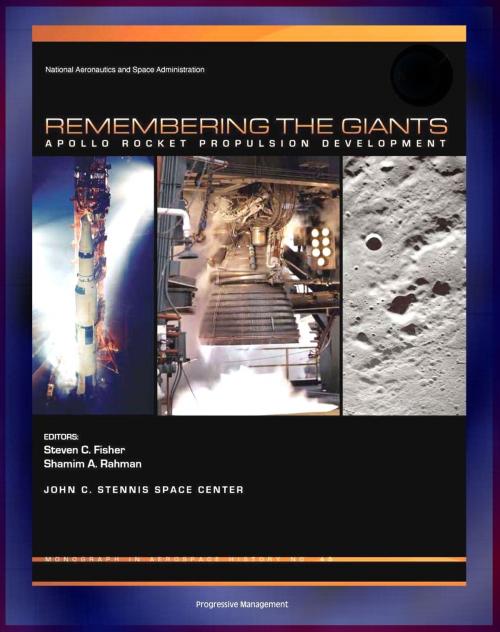Apollo and America's Moon Landing Program: Remembering The Giants - Apollo Rocket Propulsion Development (NASA SP-2009-4545) - Saturn V, CSM, and Lunar Module Engines Including F-1, J-2, and SPS
Nonfiction, Science & Nature, Science, Physics, Astronomy, History, Americas| Author: | Progressive Management | ISBN: | 9781465988485 |
| Publisher: | Progressive Management | Publication: | December 23, 2011 |
| Imprint: | Smashwords Edition | Language: | English |
| Author: | Progressive Management |
| ISBN: | 9781465988485 |
| Publisher: | Progressive Management |
| Publication: | December 23, 2011 |
| Imprint: | Smashwords Edition |
| Language: | English |
This official NASA document - converted for accurate flowing-text ebook format reproduction - provides a historical compendium of what will likely be remembered as one of the most remarkable achievements in the evolution of rocket propulsion. This achievement was the simultaneous development, testing, and flight use of a series of first-ever propulsive devices that delivered Apollo 11 astronauts safely to the surface of the moon and back to Earth. These devices helped assure three individuals, Armstrong, Aldrin, and Collins a place in the history of humankind. From the F-1 booster engine to the lunar module ascent engine of the Apollo vehicle stack — all built and delivered by the new United States space industrial base — these individual rocket propulsion development stories provide a glimpse of how technical ingenuity rose to meet the challenge of the race to the moon. The development histories and lessons learned about the various engines are told by the engineers and project managers, and were recorded on DVD so that the lecture series held at NASA's John C. Stennis Space Center near Bay St. Louis, Mississippi, could be replayed again and thus live on. Remarkably, to those who attended, it was apparent that these speakers recalled their Apollo challenges as if they had happened "just yesterday." It was clear in their voices that the engines carried not just the hardware but also the hope of the nation that this "moon shot" could even be done at all.
Although this monograph comes some years after the actual date of the lectures, and describes work from decades ago, the lessons will continue to carry space exploration forward. The story told within is not how one particular engine was built, but rather how ordinary people persisted and were driven to do extraordinary work. The country owes these resourceful and dedicated engineers a debt of gratitude for giving us the technical precedents upon which today's space programs rest in a continuing story of human exploration.
This ebook is an invaluable addition to the library of anyone interested in the Apollo moon landings.
Contents: Chapter One - Robert Biggs, Rocketdyne - F-1 Saturn V First Stage Engine * Chapter Two - Paul Coffman, Rocketdyne - J-2 Saturn V 2nd & 3rd Stage Engine * Chapter Three - Gerald R. Pfeifer, Aerojet - Attitude Control Engines * Chapter Four - Tim Harmon, Rocketdyne - SE-7 & SE-8 Engines * Chapter Five - Clay Boyce, Aerojet - AJ10-137 Apollo Service Module Engine * Chapter Six - Gerard Elverum, TRW - Lunar Descent Engine * Chapter Seven - Tim Harmon, Rocketdyne - Lunar Ascent Engine
This official NASA document - converted for accurate flowing-text ebook format reproduction - provides a historical compendium of what will likely be remembered as one of the most remarkable achievements in the evolution of rocket propulsion. This achievement was the simultaneous development, testing, and flight use of a series of first-ever propulsive devices that delivered Apollo 11 astronauts safely to the surface of the moon and back to Earth. These devices helped assure three individuals, Armstrong, Aldrin, and Collins a place in the history of humankind. From the F-1 booster engine to the lunar module ascent engine of the Apollo vehicle stack — all built and delivered by the new United States space industrial base — these individual rocket propulsion development stories provide a glimpse of how technical ingenuity rose to meet the challenge of the race to the moon. The development histories and lessons learned about the various engines are told by the engineers and project managers, and were recorded on DVD so that the lecture series held at NASA's John C. Stennis Space Center near Bay St. Louis, Mississippi, could be replayed again and thus live on. Remarkably, to those who attended, it was apparent that these speakers recalled their Apollo challenges as if they had happened "just yesterday." It was clear in their voices that the engines carried not just the hardware but also the hope of the nation that this "moon shot" could even be done at all.
Although this monograph comes some years after the actual date of the lectures, and describes work from decades ago, the lessons will continue to carry space exploration forward. The story told within is not how one particular engine was built, but rather how ordinary people persisted and were driven to do extraordinary work. The country owes these resourceful and dedicated engineers a debt of gratitude for giving us the technical precedents upon which today's space programs rest in a continuing story of human exploration.
This ebook is an invaluable addition to the library of anyone interested in the Apollo moon landings.
Contents: Chapter One - Robert Biggs, Rocketdyne - F-1 Saturn V First Stage Engine * Chapter Two - Paul Coffman, Rocketdyne - J-2 Saturn V 2nd & 3rd Stage Engine * Chapter Three - Gerald R. Pfeifer, Aerojet - Attitude Control Engines * Chapter Four - Tim Harmon, Rocketdyne - SE-7 & SE-8 Engines * Chapter Five - Clay Boyce, Aerojet - AJ10-137 Apollo Service Module Engine * Chapter Six - Gerard Elverum, TRW - Lunar Descent Engine * Chapter Seven - Tim Harmon, Rocketdyne - Lunar Ascent Engine















